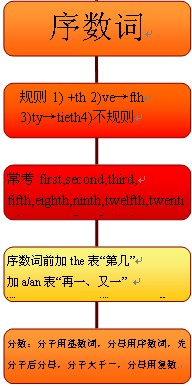本试题 “出国游有许多需要注意的事项。而付小费是很多国家的普遍现象。由于文化习俗的差异,不同的国家、不同的地区做法不尽相同。以下A、B、C、D、E和F是对亚洲一些...” 主要考查您对序数词
等考点的理解。关于这些考点您可以点击下面的选项卡查看详细档案。
- 序数词
序数词的概念:
表示顺序的数称为序数词。如:first, second, third, fourth。
序数词的构成与用法:
1、序数词的构成:
①一般来说,是由相应的基数词加词尾th构成。
例:four+th→fourth
six+th→sixth
seven+th→seventh
ten+th→tenth
②下面这些基数词在变为序数词时,有特殊的变化。
例:one→first
two→second
three→third
five→fifth
eight→eighth
nine→ninth
twelve→twelfth
③十位整数序数词的构成方法是将基数词的词y变成i,然后再加eth。
例:twenty→twentieth
thirty→thirtieth
forty→fortieth
ninety→ninetieth
④两位或两位以上的基数词变成序数词时,仅将个位数变成序数词。
例:twenty-one→twenty-first
thirty-five→thirty-fifth
a hundred and fifty-three→a hundred and fifty-third
2、序数词的用法:
①序数词在使用时,一般加上定冠词。
例:the first book
the second floor
the third day
the fourth week.
②序数词在多数情况下都用作定语,有的也可以作表语、主语和宾语。
例:The may1st is Labour Day. 五月一日是劳动节。
My room is on the second floor. 我的房间在二楼。
The first is larger than the secon.(主语)第一个比第二个大。
Read the book from the first.(宾语)从开头读这本书。
You'll be the sixth to write.(表语)你将是第六个写的。
③序数词的前面可以加上不定冠词,用来表示“再一”,“又一”的意思。
例:You may have a third try. 你可以第三次尝试。
序数词知识体系:

约数的表达方法:
用tens/dozens/scores/hundreds/thousands/millions of 表示“几十、几百、上千、成千上万”等。
如:The boy bought dozens of pencils.
Thousands of people died in the earthquake.
注意: (A):dozen, score, hundred, thousand, million等表示确切数量时,不用复数。
如:five dozen (of) eggs 五打鸡蛋
hree hundred people 三百个人
分数词的构成和用法:
1)分数词构成法:
分数词(FractionalNumerals)由基数词和序数词构成,基数词代表分子,序数词代表分母。除了分子为1的情况下,序数词都要用复数形式:
如:1/4:one-fourth
5/9:five-ninths
2/3:two-thirds
17/5:three and two-fifths
7/12:seven-twelfths
379/8:forty-seven and three-eighths
此外还有下面表示法:
如:1/2:a(one) half
1/4:a(one) quarter
3/4:three-quarters
9/4:two and a quarter
3/2:one and half
31/4:seven and three quarters
与“出国游有许多需要注意的事项。而付小费是很多国家的普遍现象...”考查相似的试题有:
- (P="Pinky," A= Ann)P: Hello, Ann! This is Pinky. How was your weekend?A: 小题1: P: Your whole family?A: Yes, all of u...
- Try to ______ the children down. They’re too excited.A.putB.calmC. pullD.push
- The new bridge is ________ the one built last year.A.three times as wider asB.three times the hehe ofC.three times...
- 短文改错(共10小题;每小题1分,满分10分)英语课上,老师要求同桌同学相互修改作文。假设以下便条为你同桌所写,请你对其进...
- The police came running and the crowd.A.broke offB.break intoC.broke upD.break down
- According to the law, all foreigners have to _______ with the local police within two weeks of arrival.A.associateB...
- 每空一词小题1:我爷爷虽然八十多岁了,但仍然精力充沛。Although my grandfather is over eighty, he is still _____________...
- 第II卷(非选择题共50分)第三部分 写作(共两节,满分50分)第一节 短文改错(共10小题;每小题1.5分,满分15分)此题要求...
- This building is ___ that one.A.three metres higher thanB.higher three metres thanC.so high asD.twice high as
- My mother has always _______ we eat every healthily.A.make sureB.made sureC.be sureD.sure